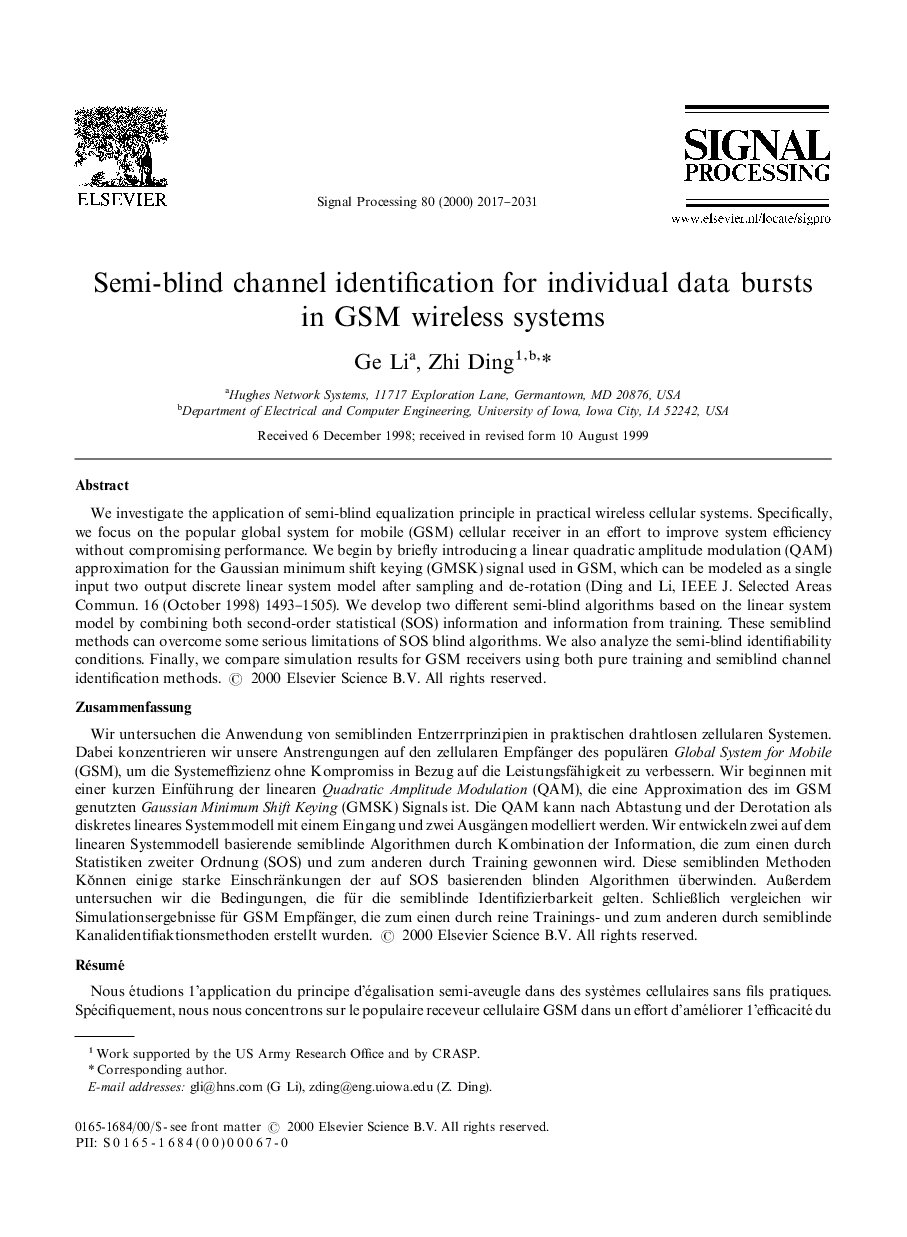| کد مقاله | کد نشریه | سال انتشار | مقاله انگلیسی | نسخه تمام متن |
|---|---|---|---|---|
| 567623 | 876119 | 2017 | 15 صفحه PDF | دانلود رایگان |
We investigate the application of semi-blind equalization principle in practical wireless cellular systems. Specifically, we focus on the popular global system for mobile (GSM) cellular receiver in an effort to improve system efficiency without compromising performance. We begin by briefly introducing a linear quadratic amplitude modulation (QAM) approximation for the Gaussian minimum shift keying (GMSK) signal used in GSM, which can be modeled as a single input two output discrete linear system model after sampling and de-rotation (Ding and Li, IEEE J. Selected Areas Commun. 16 (October 1998) 1493–1505). We develop two different semi-blind algorithms based on the linear system model by combining both second-order statistical (SOS) information and information from training. These semiblind methods can overcome some serious limitations of SOS blind algorithms. We also analyze the semi-blind identifiability conditions. Finally, we compare simulation results for GSM receivers using both pure training and semiblind channel identification methods.
ZusammenfassungWir untersuchen die Anwendung von semiblinden Entzerrprinzipien in praktischen drahtlosen zellularen Systemen. Dabei konzentrieren wir unsere Anstrengungen auf den zellularen Empfänger des populären Global System for Mobile (GSM), um die Systemeffizienz ohne Kompromiss in Bezug auf die Leistungsfähigkeit zu verbessern. Wir beginnen mit einer kurzen Einführung der linearen Quadratic Amplitude Modulation (QAM), die eine Approximation des im GSM genutzten Gaussian Minimum Shift Keying (GMSK) Signals ist. Die QAM kann nach Abtastung und der Derotation als diskretes lineares Systemmodell mit einem Eingang und zwei Ausgängen modelliert werden. Wir entwickeln zwei auf dem linearen Systemmodell basierende semiblinde Algorithmen durch Kombination der Information, die zum einen durch Statistiken zweiter Ordnung (SOS) und zum anderen durch Training gewonnen wird. Diese semiblinden Methoden Kŏnnen einige starke Einschränkungen der auf SOS basierenden blinden Algorithmen überwinden. Außerdem untersuchen wir die Bedingungen, die für die semiblinde Identifizierbarkeit gelten. Schließlich vergleichen wir Simulationsergebnisse für GSM Empfänger, die zum einen durch reine Trainings- und zum anderen durch semiblinde Kanalidentifiaktionsmethoden erstellt wurden.
RésuméNous étudions 1'application du principe d’égalisation semi-aveugle dans des systèmes cellulaires sans fils pratiques. Spécifiquement, nous nous concentrons sur le populaire receveur cellulaire GSM dans un effort d'améliorer 1'efficacité du système sans compromettre ses performances. Nous commençons par introduire brièvement une approximation de la modulation d'amplitude quadratique (QAM) linéaire pour un signal codé par décalage minimum gaussien (GMSK) utilisé en GSM, qui peut être modélisé comme un système linéaire à une entrée unique et à deux sorties après échantillonnage et dé-rotation. Nous avons développé deux algorithmes différents semi-aveugles basés sur le modèle de système linéaire, en combinant à la fois une information statistique de second ordre (SSO) et une information d'entraı̂nement. Ces méthodes semi-aveugles peuvent surpasser certaines limitations sérieuses des algorithmes aveugles SSO. Nous avons aussi analysé les conditions d'identifiabilité semi-aveugles. Finalement, nous comparons les résultats de simulations pour des récepteurs GSM en utilisant des méthodes d'identification de canaux semi-aveugles et purement par apprentissage.
Journal: Signal Processing - Volume 80, Issue 10, October 2000, Pages 2017–2031
